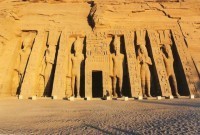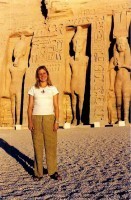Abu Simbel, Day 291
Although we are in the heat of a Saharan summer the air-conditioner in our room at the Horus Hotel is so effective that I’m tucked into my three-season sleeping bag and in addition to my pajamas I’m also wearing a fleece. You may, quite reasonably ask why I don’t just turn off the air conditioner. The answer is that on the floor above us is an all night disco – something the fixer must have forgotten to mention – and the white noise emanating from the air-conditioner is loud enough to block out the blaring disco music. This explains why the room was so cheap – because you can’t actually sleep in it at night unless you’re willing to freeze your bits off. Perhaps the other guests are all at the disco and actually sleep during the day. To be fair Christi and I are not that inconvenienced this night because we get up in the middle of it to do a little sightseeing.
We are visiting Abu Simbel and the tour starts early, because the best time to see the temple is at dawn (god I hate these pre-dawn adventures). It is 280 km from Aswan to Abu Simbel, which takes 3.5 – 4 hours by minibus and costs US$200 for a private tour. Or you can fly there in 45 minutes and the cost is US$100 per person. Well that’s a no-brainer, but disappointingly we have to get up earlier for the flight than for the minibus. We take a taxi to the airport and have checked-in by 3.30 am. The flight should leave at 4 am, but is delayed by 45 minutes – severely cutting into our ground time at the temple. When we do get into the air (aboard an Air Memphis DC9) the journey only takes 30 minutes. We reach the Temple of Abu Simbel by 6 am and it’s still dark, which gives me a few moments to describe the miracle Christi and I have come here to witness. Abu Simbel should be at the bottom of Lake Nasser, but UNESCO intervened to save this complex. Between 1964-8 as the waters of the newly formed lake encroached ever closer to the temple, the UNESCO mission succeeded in cutting the complex into 2,000 sections, each weighing between 10 and 40 tons. These sections were then moved 210m inland and raised 65m in elevation. The sections of rock were then reconstructed inside specially designed, dome-shaped concrete mountains. It cost US$40 million dollars to save the temple complex.
The main feature of Abu Simbel is the Great Temple of the pharaoh Ramses II, comprising four 60-foot tall statues of the great man himself. Three of the statues remain, one apparently collapsed during an earthquake in 27 BC. Ramses II is often regarded as the greatest, most celebrated, and most powerful pharaoh of the entire Egyptian Empire. His reign lasted more than 66 years during the 19th dynasty of the New Kingdom (actually from 1279 BC – 1213 BC). By the legs of his statues are some of his wives and children. In fact it was Ramses 13th born son, Merneptah, that eventually succeeded him because Ramses II outlived the other twelve. Inside the temple are more statues of Ramses II, together with paintings and carvings, and of course the sanctuary housing statues of the gods and Ramses II.
Also part of the Abu Simbel complex is a smaller temple dedicated to Hathor (the goddess of love and pleasure) and Nefertari, Great Royal Wife (i.e. principal wife) of Ramses II. The rock-cut facade is decorated with two groups of colossi that are separated by the large gateway. The statues, slightly more than thirty feet high, are of the king and his queen. On either side of the portal are two statues of the king, wearing the white crown of Upper Egypt and the double crown of Upper and Lower Egypt. These are flanked by statues of the queen and the king, and uniquely in ancient Egypt the statue of the pharaoh is the same size as his wife. It is believed that these colossal statues were built as a warning to potential enemies to the south not to invade Egypt.
We leave the impressive temple complex of Abu Simbel just as the hordes of tour buses arrive. The return flight to Aswan is much smoother than the outbound flight and Christi and I are back in bed 2 hours after leaving the temple complex. We sleep in total peace (no booming disco) until 2 pm and then find our way to the Nile Ferry Company and the offices of Mr. Salah who will with a bit of luck allow us to pay an exorbitant fee for a grotty first-class room on the weekly ferry service to Sudan. He scans our beautiful travel permits…and then shakes his head. ‘Sudanese Immigration could still refuse entry,’ he complains. ‘And then I will have to bring you back to Aswan and that will cost my company money. You need to get entry visas from the Sudanese consulate here in Aswan before I can issue your tickets.’
‘I’ll keep your tickets on hold until tomorrow night. But no visa, no ticket.’
Bugger.
I seriously doubt whether Ramses II at the height of his power could have subjugated the bureaucratic behemoths that run Egypt and Sudan, but I know which side I’d be on.




Blog post by Roderick Phillips, author of Weary Heart – a gut-wrenching tale of love and test tubes.
The post Abu Simbel, Day 291 appeared first on Roderick Phillips.




